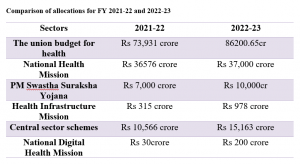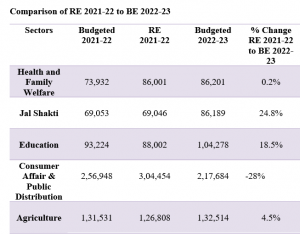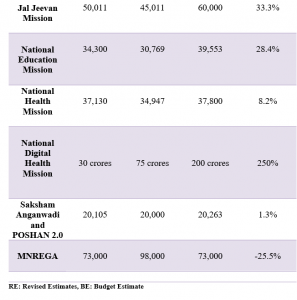
Public health has never been a priority for Indian governments. It took a pandemic to sensitise the government to the importance of a robust public healthcare system, but it seems the realisation was ephemeral. The Economic Survey 2021–22 managed to create a mirage of opportunities for investment in healthcare and raise a lot of expectations.
While presenting her fourth Union budget, finance minister Nirmala Sitharaman emphasised the need to bolster the healthcare sector in her opening statement. “We are in the midst of the Omicron wave. The speed of our vaccination campaign has helped greatly with the accelerated improvement of health infrastructure in the past two years, and we are in a strong position to withstand challenges.” Though it came in the midst of a raging global pandemic, Budget 2022 did not have a ‘health’ focus.
READ I Public health: Profit motive, state inaction dictate outcomes
Budget 2022 and public health
Budget 2022 allocated Rs 86,200.65 crore to health, 16% more than last year’s allocation of Rs 73,931 crore. Budget 2021 had boosted the allocation by 37% compared with the previous budget. Despite the double-digit increase in allocation, the target of 2.5% of the GDP by 2025 looks a distant dream. Allocations for Covid-19 vaccination were also cut despite the fact that only 75% of adults are fully vaccinated.

The focus of the previous year’s Budget was on the preventive, promotive, and curative aspects of healthcare. In addition to promoting research and development by bolstering public health units and labs, it also focused on infrastructure building for the core aspects of public health. Budget 2022 was expected to build on the momentum created in 2021–22. The budget envisioned the next 25 years, with no sound vision for healthcare.


In Budget 2021, the government outlined various policies to boost innovation and investment to improve healthcare services. The budget contained several incentives for R&D and innovation. This year, with a focus on ‘health for all’, the government has shone a light on some of the most pressing health issues in the nation.
READ I Universal pension can transform Indian economy
What’s in for healthcare
Budget 2022 has addressed the issue of mental health and the damage caused by the pandemic. The 23 telemental health centres of excellence in collaboration with NIMHANS and IIT-Bangalore will work under the National Telemental Health programme. Mental health is a serious public health issue that claims the lives of 970 million individuals worldwide.
The agenda of ‘health for all’ will be achieved through the use of the digital infrastructure for healthcare which got a massive impetus during the pandemic crisis. An open platform for the national digital health ecosystem was announced, where digital registry of healthcare providers, health facilities, and unique health identities will be offered to bring health facilities to people’s doorsteps and provide universal access to health facilities.
The finance minister emphasised the success India achieved in healthcare, citing reforms such as the upgradation of two lakh Anganwadis with audio-visual aids and POSHAN 2.0 to strengthen early child development. Around 95% of the 112 aspirational districts improved in their indicators above the national average.
Future of reforms
Public health is dictated by social, economic, and political conditions. Thus, any reform introduced at the national level pertaining to health, economy, environment, or societal issues will have an effect on health across demographies. Although various reforms announced in Budget 2022 are intended to boost the economy or meet global or national goals, they will have an impact on public health.
The telemental health programme will face a tough challenge while catering to the rural population and marginalised communities. While progressing towards SDG 3.4, the National Digital Health Mission will be beneficial for the migrant population which usually dictates the disease burden of any state they migrate to.
The penetration of public health programmes in villages has been a longstanding issue. The lack of accessibility due to poor connectivity and transport facilities has been a major constraint in addition to poor public health infrastructure. The Parvat Mala project, aiming to enhance village connectivity and make a commitment to strengthen health infrastructure at border villages will address this issue if implemented mindfully.
The ‘Nal Se Jal’ scheme paves the way for progress on SDG 6, 3.2, and 3.9.1, providing safe drinking water and reducing the incidence of water-borne disease burden and preventable deaths among neonates and children under five which is a major public health issue.
Education is key to deriving demographic dividend and for the health of the population. Education influences the health of an individual and sets an inter-generational cycle of good health. The FM’s announcement of a dedicated TV channel for digital education may prove beneficial for those deprived of education due to a lack of digital means, thus making progress in SDG 4.
Encouragment for chemical-free agriculture is another step towards sustainable development, producing organic food and employment opportunities. This will improve the standard of living of the agrarian community. Agricultural production is encouraged with the help of clean energy and biogas to move closer to SDG 7.
Climate change and the impact of pollution on human health result in the death of 2.5 million people every year. Budget 2022 puts stress on the impact of climate change by rolling out four pilot projects that are in line with the announcements made by Prime Minister Narendra Modi at the COP26 Summit in Glasgow. The strategy also provides employment opportunities and promotes clean energy and clean living conditions, thus making progress in SDG 3.9.
With a widening economic gap between different strata of society, these reforms are key not just to lifting the economy and the standard of living of the privileged sections, but also to helping those in desperate need for support to recover from the pandemic-induced economic crisis.
Good roads and bridges do no good if the people are unhealthy and have poor living conditions. To expose the crippled healthcare system of the nation, sustained efforts and investments are required for human resource and infrastructure development. Programmes to lift people out of poverty and reduce out-of-pocket expenditure for healthcare must be implemented urgently. The previous budget addressed the issue, but did not show sustained efforts to improve the public health system. India cannot afford complacency in this area which is crucial to its efforts to become a global economic powerhouse.
(Sharyu Mhamane is a master’s student in Public Health at MIT World Peace University, Pune.)

